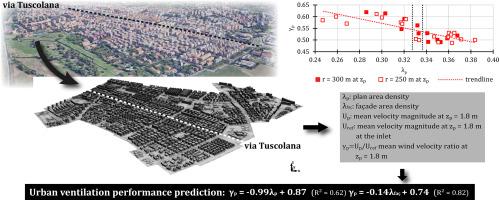Science of the Total Environment ( IF 9.8 ) Pub Date : 2021-09-23 , DOI: 10.1016/j.scitotenv.2021.150490 Olga Palusci 1 , Paolo Monti 2 , Carlo Cecere 2 , Hamid Montazeri 3 , Bert Blocken 4

|
Air pollution and heat stress are major concerns associated with the liveability, resilience and sustainability of cities. They directly affect health and comfort and are associated with augmented morbidity and mortality and an increase in the energy demand for building ventilation, air cleaning and cooling. Nevertheless, the detrimental effects of poor air quality may partly be mitigated by increased urban ventilation. This strategy is closely related to the level of urbanization and the urban morphology. Therefore, detailed investigations on the impact of different morphologies on urban ventilation are of paramount importance. Computational Fluid Dynamics simulations have been widely used during the last decades to investigate the effects of the urban morphology on the urban ventilation. However, most of these studies focused on idealized building arrangements, while detailed investigations about the role of real urban morphologies are scarce. This study investigates the ventilation in a compact area in the city of Rome, Italy. 3D steady-state Reynolds-averaged Navier-Stokes simulations are performed to analyze the impact of Morphological Parameters (MP) on the urban ventilation. The results show a considerable worsening of urban ventilation with increasing building density with a reduction in the mean wind velocity up to 62% experienced at the pedestrian level (zp). Correlations between five MPs, e.g., plan area density, area-weighted mean building height, volume density, façade area density, and non-dimensional mean velocity at pedestrian level and at 10 m height are evaluated, and simple models are obtained using linear regression analysis. Among the selected MPs, the building façade area density shows a remarkable correlation with the non-dimensional mean velocity at zp (R2 = 0.82). Such correlations can be valuable tools for practitioners and urban designers, particularly during the first stage of planning, for highlighting areas potentially vulnerable to poor air conditions without running computationally expensive simulations.
中文翻译:

形态参数对紧凑型城市城市通风的影响:以罗马 Tuscolano-Don Bosco 区为例
空气污染和热应激是与城市宜居性、弹性和可持续性相关的主要问题。它们直接影响健康和舒适度,并与发病率和死亡率增加以及建筑物通风、空气净化和冷却的能源需求增加有关。然而,空气质量差的不利影响可能会通过增加城市通风而得到部分缓解。这一战略与城市化水平和城市形态密切相关。因此,详细研究不同形态对城市通风的影响至关重要。在过去的几十年中,计算流体动力学模拟已被广泛用于研究城市形态对城市通风的影响。然而,这些研究大多集中在理想化的建筑布置上,而关于真实城市形态作用的详细调查却很少。这项研究调查了意大利罗马市一个紧凑区域的通风情况。执行 3D 稳态雷诺平均 Navier-Stokes 模拟以分析形态参数 (MP) 对城市通风的影响。结果表明,随着建筑密度的增加,城市通风显着恶化,行人水平的平均风速降低了 62% (z 执行 3D 稳态雷诺平均 Navier-Stokes 模拟以分析形态参数 (MP) 对城市通风的影响。结果表明,随着建筑密度的增加,城市通风显着恶化,行人水平的平均风速降低了 62% (z 执行 3D 稳态雷诺平均 Navier-Stokes 模拟以分析形态参数 (MP) 对城市通风的影响。结果表明,随着建筑密度的增加,城市通风显着恶化,行人水平的平均风速降低了 62% (zp )。评估了五个 MP 之间的相关性,例如规划面积密度、面积加权平均建筑高度、体积密度、立面面积密度和行人水平和 10 m 高度的无量纲平均速度,并使用线性回归获得简单模型分析。在选定的 MP 中,建筑立面面积密度与 z p (R 2 = 0.82)处的无量纲平均速度显着相关。这种相关性对于从业者和城市设计师来说是有价值的工具,特别是在规划的第一阶段,用于突出可能易受恶劣空气条件影响的区域,而无需运行计算成本高的模拟。


























 京公网安备 11010802027423号
京公网安备 11010802027423号